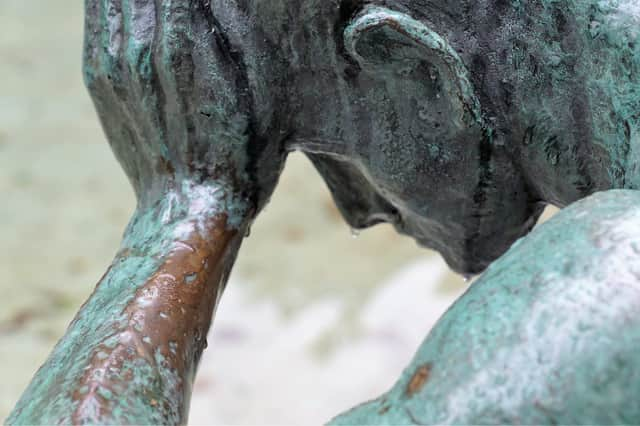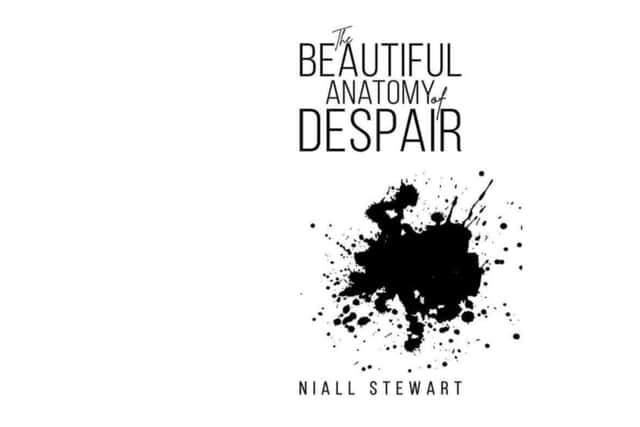Must-read of the week: The beautiful anatomy of despair by Niall Stewart
This article contains affiliate links. We may earn a small commission on items purchased through this article, but that does not affect our editorial judgement.


New psychological debut novel The Beautiful Anatomy of Despair by Niall Stewart is a brilliant examination of angst, suffering and coming to terms with loss in a modern, individualistic society.
By Gwyneth Rees
The Beautiful Anatomy of Despair by debut author Niall Stewart is a surprisingly uplifting tragicomedy about loving, belonging and hoping, woven together by the poignant stories of its four central characters.
A timely work of literary fiction with significant psychological—and sociological—depth, it examines the fundamental question of what makes us happy, and considers whether striving for happiness as an end goal is really a sensible and worthwhile act.
You could, then, in a sense, describe it as a lyrical philosophical study on how to go about your life, acted out by four driven friends who on the surface seem to be driving forward yet at the same time continue to lurch from personal crisis to crisis in their blinkered quest for material success.
These two states of being, as we soon come to learn, are intrinsically connected and, indeed, the opening paragraphs of the novel set out perfectly what is to be explored:
The Aristotelian path to happiness is surely a treacherous one, demanding our excellence and virtue at every step. What can we learn, really, from people who were resolute it is not the
purpose of life to be happy? What, really, is the point of well-being if it does not contain at least occasional pleasure? Are we to be dismissed as hedonists because it is better when the pleasant outweighs the painful?
We are wired to seek out happiness; it guarantees us some sort of future, and we are condemned to pursue it forever.


The story begins at a meditation retreat in San Francisco in 2014, where we meet Tristan, a contemplative 20-something British legal professional looking to find himself.
Here, he is drawn to Seb, a younger, more confident man with whom he is keen to strike up a friendship. Following the retreat, he starts spending time with Seb and eventually joins him and Seb’s older sister, Camilla, at a society dinner.
But then the narrative jumps to a new set-up and new character, this time Toby, who works a 14-hour day city job in London and is attending parties in the evening with his careless, hedonistic friend, Igor.
Painfully shy and crippled with self-doubt and self-hatred, Toby puts on a front of contentment while being secretly distressed about how everyone seems to be having a better life than him.
“Is it too late to pretend to be someone else?” he muses at a party. The next evening, he is trashing his apartment as alcohol releases the full fury of his inner-loathing.
Next, we jump to Italy’s Amalfi Coast, where Cordelia Green is tied to her long-term boyfriend Freddie despite (or perhaps because) of the fact it makes both their lives more difficult.
But after Cordelia receives some bad family news, it falls to Freddie to return to London to inform her parents that she is missing.
It’s on this cliff-hanger that we jump forward to 2017 and back to Tristan, in a gut-wrenching scene about devastating heartbreak.
We find him writing a letter to his now-ex, Seb, detailing how—one year on from their parting—he searches for him on the internet and still follows his movements from afar, spending all his time wondering how to go on without him.
The grief and loss so frankly expressed by Tristan will be relatable to everyone but there is little doubt that this has become obsessional, and that his former partner was as much of a shield against the emptiness inside as a lover.
What I particularly love about The Beautiful Anatomy of Despair is how dark yet honest emotions are portrayed unfiltered and with no promise of quick recovery.
With Tristan, we watch as he wallows in his misery. If only Seb could witness his desolation, he would return, Tristan muses—while, of course, the very opposite is true.
To his credit, Tristan does try to get better. For instance, he ploughs through biographies and autobiographies, consoled somewhat by the shared complexity of other people’s lives.
We cheer for him, willing him to improve, while through access to some of Seb’s diary entries we also come to learn more about their relationship and how it was doomed with Seb’s infidelity and growing sense of relationship ennui.
What is expressed so well in these well-realised characters is how the pursuit of distraction—travel, work, parties— is to try and mask an unnerving sense of not knowing where life is heading or their place within it.


They are connected as friends and occasional lovers yet each is truly alone and, deep down, they recognise this as they battle with inner demons.
For instance, academic Igor is starting to tire of his party-boy lifestyle as he enters his 30s while investment banker Toby becomes more resentful as he tries to keep up the appearance of success.
And as the book’s exquisite title suggests, there is more turmoil to come, with devastating secrets unearthed and events spiralling out of the characters’ control, insisting a reconciliation with life as it is, and with themselves as they really are.
Not all of them, however, will be able to make this crucial transition.
All told then, this is both a simple and complex narrative, brilliantly executed by author Niall Stewart.
Perhaps this line in the book sums it up best: “We’re just people, muddling along as best we can. I will not be made to feel guilty about it.”
A bold and original psychodrama that skewers the world as we know it, The Beautiful Anatomy of Despair is also a sensitive and perceptive social commentary on the futility of pursuing happiness as life’s goal.
On the contrary, it shows us how, instead of trying to manipulate life and seek unrealistic expectations of happiness, we should perhaps concentrate on genuine connections, both with ourselves and others.
The prose is articulate without falling into the trap of self-indulgence—a common issue with literary fiction—and the ideas explored are elucidated clearly through the narrative and cast.
It’s not every day that you come across a novel tackling the views of philosophers such as Aristotle and the Epicureans that is so imaginative and absorbing.
We come to care for the plights of the characters, however personally flawed they may be, and this helps illuminate the sound life lessons being put forth, such as consideration of why we give our power so freely to others, why we attach meaning to things that don’t really matter, and how can we live our own lives when sheltering in another’s apartment?
The intricate character studies are to be praised and the mixture of light and dark, littered with many throw-away but spot-on observations, make the novel—despite the sobering tenor—a joy to devour.
Most of all, I loved the dark nights of the soul, where the false exterior falls away and leaves fears exposed. It is part of being human, and this honesty is impactful. At times, you are deeper beneath the skin of a given character than they are.
In conclusion then, this is a triumphant literary debut that manages to take a bleak outlook and turn it into a bold new take on reinvention and its limits.
Particularly relevant to today’s post-modern, thrill-seeking generation, it claws out the inner piping of the Generation Z and Millennial crowd, shining an interrogatory light into well-groomed faces with rictus smiles.
The Beautiful Anatomy of Despair is on full display and handled with the intelligence, care and spectacle of a medical school dissection.
The Beautiful Anatomy of Despair by Niall Stewart (Austin Macauley Publishers) is out now on Amazon, in paperback, hardcover and eBook, priced at £8.99, £12.99 and £3.50 respectively. For more information, visit www.niallstewart.co.uk or follow him on Twitter or Instagram @nialltfstewart.
Q&A INTERVIEW WITH AUTHOR NIALL STEWART
Author Niall Stewart has made a confident literary debut with his thought-provoking novel The Beautiful Anatomy of Despair. We caught up with the author, who is based in Edinburgh and London, to find out more about the book’s philosophical exploration of the pursuit of happiness and social examination of modern masculinity.


Q: How would you sum up The Beautiful Anatomy of Despair?
A: Anatomy is a novel about the pursuit of happiness; a group of friends struggling in the modern world, coming to terms with what it requires of them, and trying to find their place in it. These are characters who want to know what happiness looks like, and they’re asking whether it’s achievable, and if it is, at what price to themselves and others it is achieved.
Q: What inspired you to become an author, and how have you found the journey thus far?
A: Writing is a way to figure out the world and the human condition in all its beautiful squalor. Also, if you’re fascinated by people but enjoy your own company, the life of a novelist offers the best of both worlds: I people-watch when I’m having my morning coffee in one of my local cafes, but then I adjourn home to my laptop, insulated from the outside world, and create my own virtual reality. The journey thus far? Seductive, and occasionally perilous.
Q: What personal life lessons have you drawn on for the ideas explored in your novel?
A: The biggest lesson life has taught me so far is that if you’re looking for answers, make sure you’re asking the right questions. This, in many ways, is the experience of the characters in The Beautiful Anatomy of Despair. And like all of us, they want answers to the big questions: what do they want their lives to look like? Should they accept their lot or strive to alter it? Life is a journey, but who’s driving the bus? And if it’s not us, how do we get our hands on the wheel?
Q: You have said that it can be difficult to distinguish between cheerfulness and despair. Can you explain what you mean?
A: We can all project a cheerfulness we’re not feeling—fake it till you make it. These days, that approach is so instinctive, we’re not always aware we’re doing it. So, there’s that. But there’s another angle to it. Pain and pleasure so often spring from the same source, and sometimes what should be our best moment turns into our worst. “At your highest moment, be careful, that’s when the devil comes for you,” as Denzel Washington recently told Will Smith.
Q: Your novel, in a sense, celebrates a more mournful outlook on life. Why is despair worth praise?
A: Out of the wound comes salvation. Or, as Franklin D. Roosevelt put it, “Only if you’ve been in the deepest valley can you ever know how magnificent it is to be on the highest mountain.” In any event, some degree of despair is unavoidable, and a life spent striving to avoid pain, or pretending it doesn’t exist, or downplaying the havoc it can wreak, strikes me as a brittle form of salvation. The pursuit of the ‘perfect life’—the Hobbesian endless circle of desire, round and round we go—is a really good way to make ourselves miserable because we can never satisfy all our wants.
Q: Why did you choose to explore the themes of despair, loneliness and the blind pursuit of happiness through mostly male characters?
A: I wanted to study society’s shifting expectations of maleness. The crisis of masculinity is, I think, one of the great issues of our time. So much machismo comes from a place of insecurity, modelled on some abstract idea of power, and I thought it would be interesting to explore what happens to an individual who is at odds with the world but who no longer has any real control over what happens to him in it.
Q: What was the greatest challenge you faced in writing your novel, and how did you overcome it?
A: Persuading my family it was worth giving up a “very promising legal career” to write it. But I can be very persuasive!
Q: What do you hope readers will gain from reading your novel?
A: I hope they see in my version of reality a world they recognise. In effect: ‘Yes, that is the way it is!’
Q: As well as on Amazon and Waterstones, your book is available at numerous independent bookstores across the UK. As a book lover yourself, why do you think it important that independent bookstores are championed?
A: I love an indie bookshop! They’re communities, and their stock is so carefully curated: it’s an invitation into someone’s personal collection.
Q: What can we expect from you next?
A: Something very different. Perhaps a comedy. It’s important to show range, as my piano teacher used to tell me.